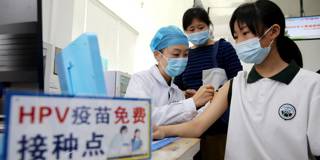If all eligible people globally were vaccinated against HPV, we could eliminate nearly all cervical cancers, while reducing the incidence of several other cancers. To achieve this outcome, however, governments must design and implement effective vaccination campaigns which account for both logistical and social barriers.
SILVER SPRING – Jessica Pettway, a YouTube fashion and lifestyle influencer, died this month from cervical cancer at the age of 36. Her untimely death – and those of countless other women – probably could have been prevented, thanks to an effective vaccine for human papillomavirus (HPV), which is responsible for about 95% of cervical cancers. But not nearly enough people are getting it.
A recent Public Health Scotland study shows just how effective the HPV vaccine is at preventing cervical cancer. Among the 40,000 women born between 1988 and 1996 who received the vaccine before turning 14, there has not been a single case of cervical cancer. This includes women who received only one or two doses, rather than the full three-dose protocol. The implication is clear: if all eligible girls and women are vaccinated globally, we could eliminate nearly all cervical cancers.
It is not just women who benefit from the HPV vaccine. Beyond cervical cancer, the vaccine protects against cancers of the head, neck, anus, penis, vagina, and vulva. Moreover, because HPV is typically transmitted sexually, protecting boys also means protecting girls. That is why all girls and boys aged 9-14 years – and, ideally, women and men until the age of 45 – should be getting the vaccine.

SILVER SPRING – Jessica Pettway, a YouTube fashion and lifestyle influencer, died this month from cervical cancer at the age of 36. Her untimely death – and those of countless other women – probably could have been prevented, thanks to an effective vaccine for human papillomavirus (HPV), which is responsible for about 95% of cervical cancers. But not nearly enough people are getting it.
A recent Public Health Scotland study shows just how effective the HPV vaccine is at preventing cervical cancer. Among the 40,000 women born between 1988 and 1996 who received the vaccine before turning 14, there has not been a single case of cervical cancer. This includes women who received only one or two doses, rather than the full three-dose protocol. The implication is clear: if all eligible girls and women are vaccinated globally, we could eliminate nearly all cervical cancers.
It is not just women who benefit from the HPV vaccine. Beyond cervical cancer, the vaccine protects against cancers of the head, neck, anus, penis, vagina, and vulva. Moreover, because HPV is typically transmitted sexually, protecting boys also means protecting girls. That is why all girls and boys aged 9-14 years – and, ideally, women and men until the age of 45 – should be getting the vaccine.